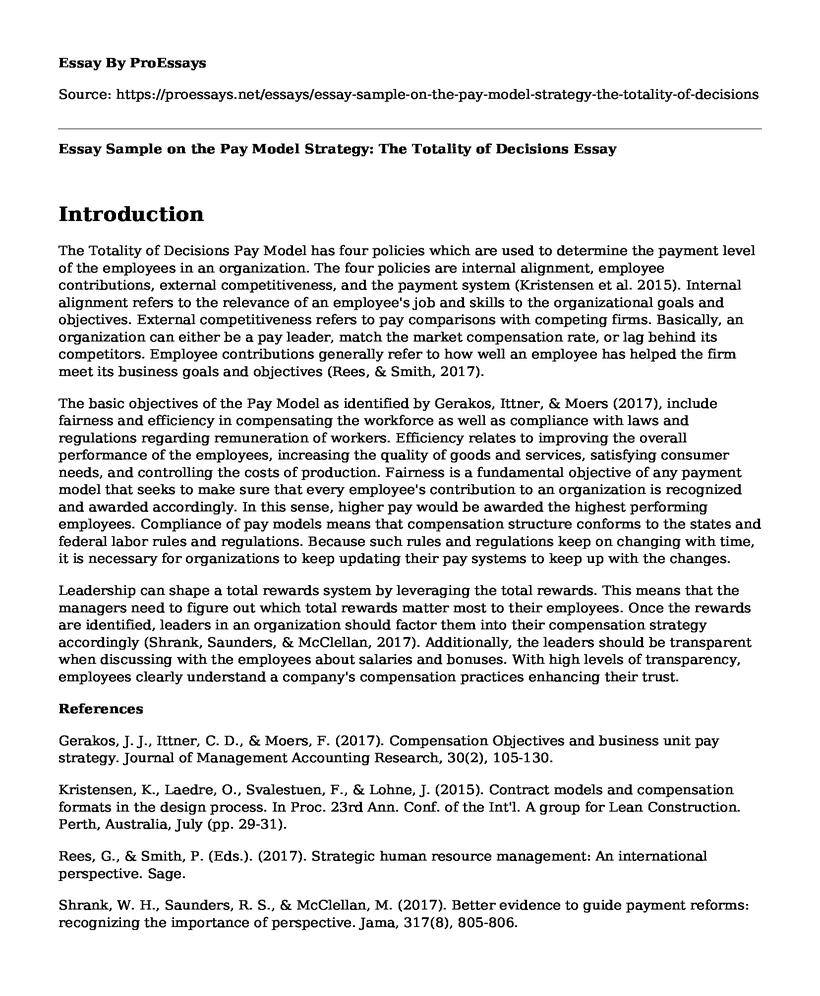Introduction
The Totality of Decisions Pay Model has four policies which are used to determine the payment level of the employees in an organization. The four policies are internal alignment, employee contributions, external competitiveness, and the payment system (Kristensen et al. 2015). Internal alignment refers to the relevance of an employee's job and skills to the organizational goals and objectives. External competitiveness refers to pay comparisons with competing firms. Basically, an organization can either be a pay leader, match the market compensation rate, or lag behind its competitors. Employee contributions generally refer to how well an employee has helped the firm meet its business goals and objectives (Rees, & Smith, 2017).
The basic objectives of the Pay Model as identified by Gerakos, Ittner, & Moers (2017), include fairness and efficiency in compensating the workforce as well as compliance with laws and regulations regarding remuneration of workers. Efficiency relates to improving the overall performance of the employees, increasing the quality of goods and services, satisfying consumer needs, and controlling the costs of production. Fairness is a fundamental objective of any payment model that seeks to make sure that every employee's contribution to an organization is recognized and awarded accordingly. In this sense, higher pay would be awarded the highest performing employees. Compliance of pay models means that compensation structure conforms to the states and federal labor rules and regulations. Because such rules and regulations keep on changing with time, it is necessary for organizations to keep updating their pay systems to keep up with the changes.
Leadership can shape a total rewards system by leveraging the total rewards. This means that the managers need to figure out which total rewards matter most to their employees. Once the rewards are identified, leaders in an organization should factor them into their compensation strategy accordingly (Shrank, Saunders, & McClellan, 2017). Additionally, the leaders should be transparent when discussing with the employees about salaries and bonuses. With high levels of transparency, employees clearly understand a company's compensation practices enhancing their trust.
References
Gerakos, J. J., Ittner, C. D., & Moers, F. (2017). Compensation Objectives and business unit pay strategy. Journal of Management Accounting Research, 30(2), 105-130.
Kristensen, K., Laedre, O., Svalestuen, F., & Lohne, J. (2015). Contract models and compensation formats in the design process. In Proc. 23rd Ann. Conf. of the Int'l. A group for Lean Construction. Perth, Australia, July (pp. 29-31).
Rees, G., & Smith, P. (Eds.). (2017). Strategic human resource management: An international perspective. Sage.
Shrank, W. H., Saunders, R. S., & McClellan, M. (2017). Better evidence to guide payment reforms: recognizing the importance of perspective. Jama, 317(8), 805-806.
Cite this page
Essay Sample on the Pay Model Strategy: The Totality of Decisions. (2022, Nov 11). Retrieved from https://proessays.net/essays/essay-sample-on-the-pay-model-strategy-the-totality-of-decisions
If you are the original author of this essay and no longer wish to have it published on the ProEssays website, please click below to request its removal:
- An Outline of the Individual and Examples of their Leadership Behavior
- Southwest Airlines's Consulting Problem Paper Example
- Employment Laws, Policies and Processes Essay Example
- Communities of Practice Paper Example
- Essay Sample on Maximizing Performance with Simplification & Innovation Strategies
- Capitalism & Slavery: Exploring the Interconnections - Essay Sample
- Exploring Religion & Globalization: Understanding Their Impact on Life







